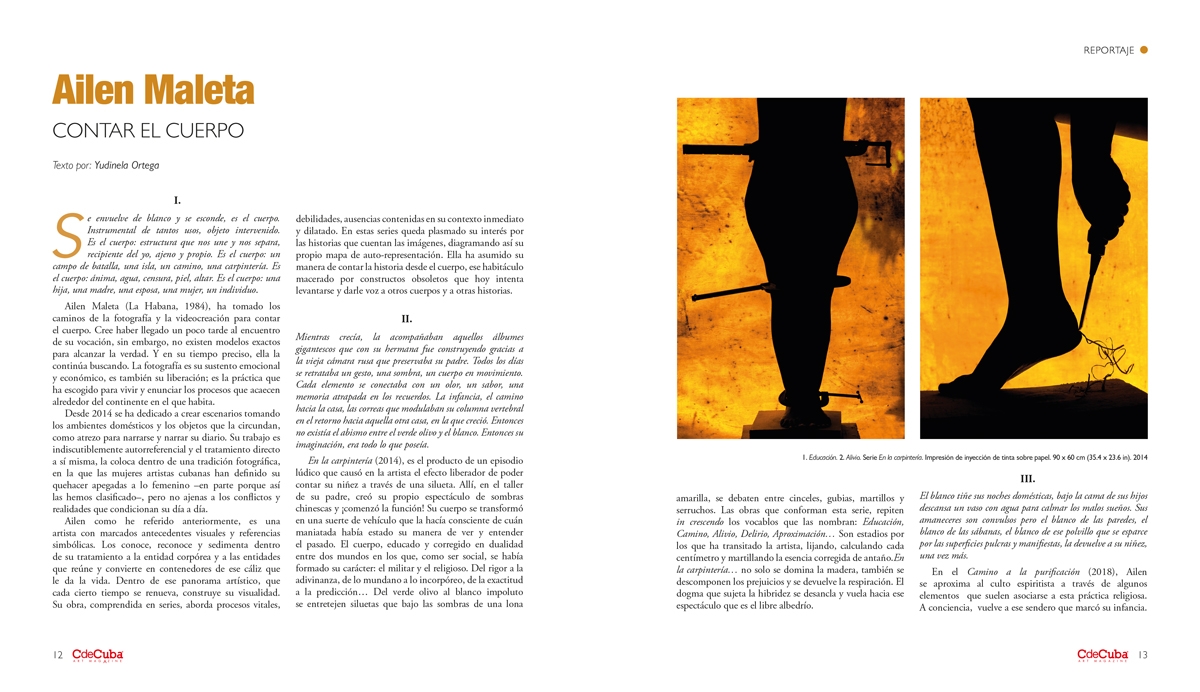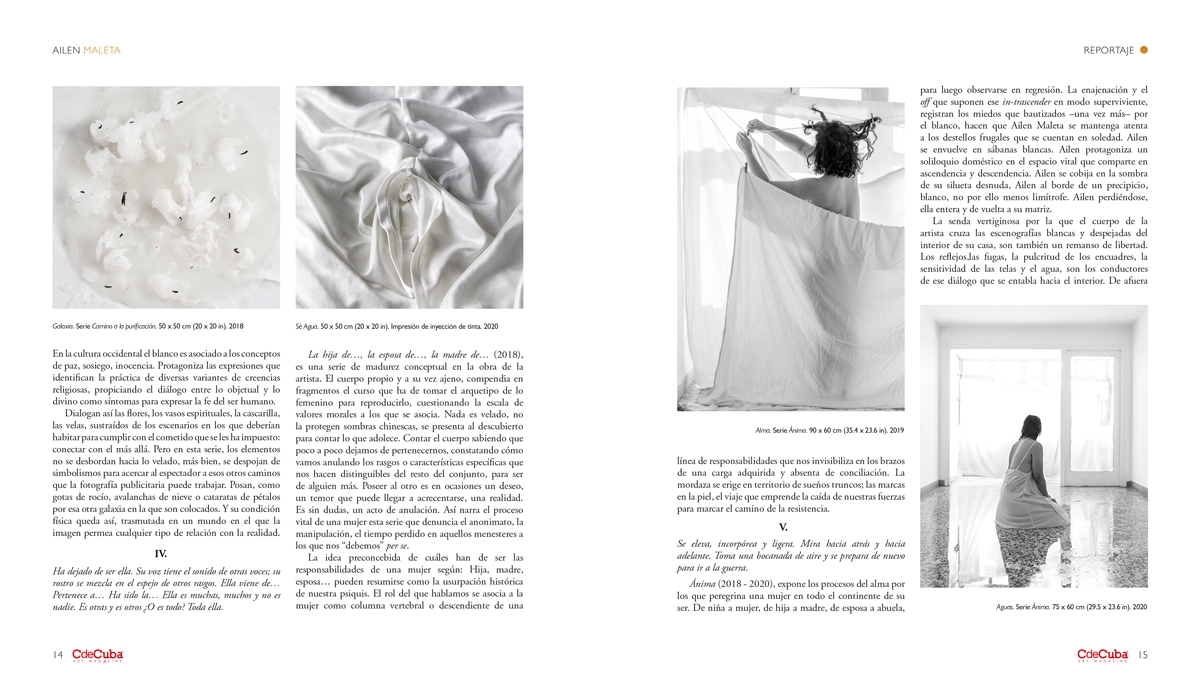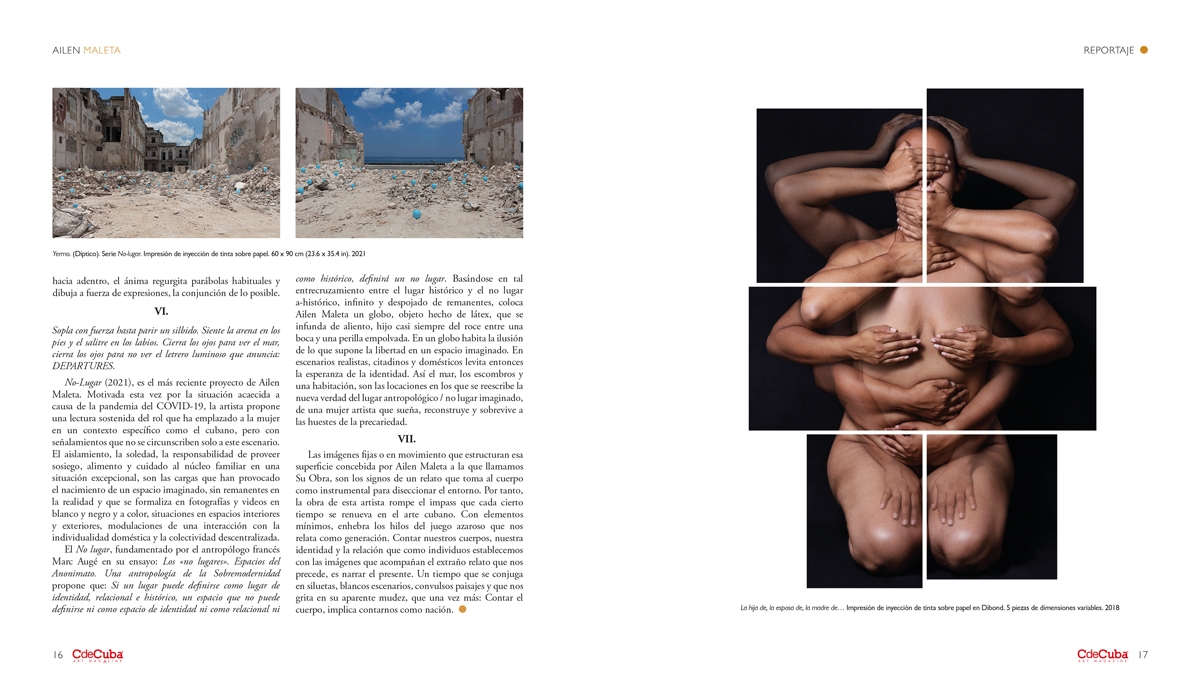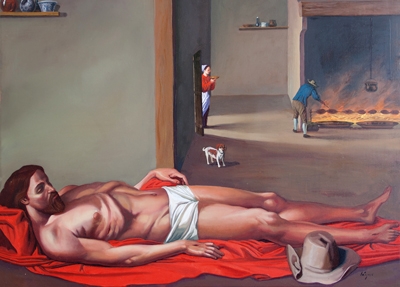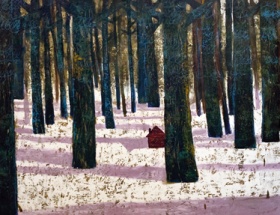Counting the Body
By Yudinela Ortega
I.
Wrapped in white and hidden, it is the body. Instrumental of so many uses, intervened object. It is the body: structure that unites and separates us, container of the self, alien and our own. It is the body: a battlefield, an island, a road, a carpentry. It is the body: soul, water, censorship, skin, altar. It is the body: a daughter, a mother, a wife, a woman, an individual. It is my body that exalts itself. It is your body, which offers you multiple shelters and you take advantage of them, to return to the day and the hour in which you decided to embark on this path.
Ailen Maleta (Havana, Cuba, 1984), has taken the paths of photography and video creation to tell the body. She believes she has arrived a little late to find her vocation, however, there are no exact models to reach the truth. And in her precise time, she continues to search for it. Photography is her emotional and economic sustenance, it is also her liberation; it is the practice she has chosen to live and enunciate the processes that occur around the continent she inhabits.
Since 2014 she has dedicated herself to creating scenarios taking domestic environments and the objects that surround her, as props to narrate herself and her diary. Her work is indisputably self-referential and the direct treatment to herself, places her within a photographic tradition, in which Cuban women artists have defined their work attached to the feminine -in part because that is how we have classified them- , but not alien to the conflicts and realities that condition their day to day. In the arduous task of showing life -to do it from one’s own perspective- as it is, as we believe it to be and how we want it to be, I would include antecedents and contemporaries: Marta María Pérez, Cirenaica Moreira, Lidzie Alvisa, Katiuska Saavedra, Sandra Ramos, Aimé García… Yanahara Mauri, Khadis de la Rosa, Lianet Pérez, Paola Martínez Fiterre, Alicia Alvisa Alejandra Glez… And other more names that I could list in this text, but that will remain as a debt to be settled in other writings. Telling about the body does not only require telling about the feminine.
Ailen, as I have previously mentioned, is an artist with a marked visual background and symbolic references. She knows them, recognizes them and sediments them in her treatment of the corporeal entity and the entities she gathers and turns into containers of that chalice that gives her life. Within this artistic panorama, which is renewed from time to time, she builds her visuality. Her work, comprised in series, deals with vital processes, weaknesses, absences contained in his immediate and dilated context. These series reflect her interest in the stories told by the images, thus diagramming her own map of self-representation. She has assumed her way of telling the story from the body, that habitat macerated by obsolete constructs that today tries to stand up and give voice to other bodies and other stories.
II.
As she grew up, she was accompanied by those gigantic albums that she built with her sister thanks to the old Russian camera preserved by her father. Every day a gesture, a shadow, a body in movement was portrayed. Each element was connected to a smell, a taste, a memory trapped in memories. Childhood, the way to the house, the straps that modulated her spine in the return to that other house, where she grew up. Then there was no abyss between olive green and white. Then her imagination was all she possessed.
In the Carpentry (2014), is the product of a playful episode that caused in the artist the liberating effect of being able to tell her childhood through a silhouette. There, in her father’s workshop, she created her own shadow show and the show began! Her body was transformed into a sort of vehicle that made her aware of how bound her way of seeing and understanding the past had been. The body, educated and corrected in duality between two worlds in which, as a social being, her character had been formed: the military and the religious. From rigor to guessing, from the mundane to the incorporeal, from accuracy to prediction… From olive green to pure white, silhouettes are interwoven under the shadows of a yellow canvas, struggling between chisels, gouges, hammers and saws. The works that make up this series, repeat in crescendo the words that name them: Education, Path, Relief, Delirium, Approximation… They are stages through which the artist has passed, sanding, calculating every centimeter and hammering the corrected essence of yesteryear. In carpentry… not only the wood is mastered, but also the prejudices are broken down and the breath is returned. The dogma that holds the hybridity is unanchored and flies towards that spectacle that is free will.
III.
White stains her domestic nights, under her children’s bed rests a glass of water to calm bad dreams. Her dawns are convulsive but the white of the walls, the white of the sheets, the white of that dust that spreads on the neat and manifest surfaces, brings her back to her childhood, once again.
In Camino a la purificación (2018), Ailen approaches the spiritualist cult through some elements that are usually associated with this religious practice. Consciously, she returns to that path that marked her childhood, in which white as a value, is crowned sign of spirituality. In Western culture, white is associated with the concepts of peace, tranquility and innocence. It stars in the expressions that identify the practice of various variants of religious beliefs, promoting dialogue between the objectual and the divine as symptoms to express the faith of the human being.
The flowers, the spiritual vessels, the husks, the candles, subtracted from the scenarios in which they should inhabit to fulfill the task that has been imposed on them: to connect with the beyond. But in this series, the elements do not overflow into the veiled, rather, they are stripped of symbolism to bring the viewer closer to those other paths that advertising photography can work. They pose, like drops of dew, avalanches of snow or cataracts of petals for that other galaxy in which they are placed. And their physical condition is thus transmuted into a world in which the image permeates any kind of relationship with reality.
IV.
She is no longer herself. Her voice has the sound of other voices; her face is mixed in the mirror of other features. She comes from… She belongs to… She has been the… She is many, many and is no one. She is others and she is others Or is she all? All of her.
La hija de…, la esposa de…, la madre de… (2018), is a series of conceptual maturity in the artist’s work. The body itself and at the same time foreign, summarizes in fragments the course that the archetype of the feminine must take in order to reproduce it, questioning the scale of moral values to which it is associated. Nothing is veiled, she is not protected by shadowy shadows, she presents herself in the open to tell what she suffers from. To tell the body knowing that little by little we cease to belong to ourselves, noting how we are annulling the specific features or characteristics that make us distinguishable from the rest of the group, to be someone else’s. To possess the other is sometimes a desire, a fear that can grow, a reality. It is undoubtedly an act of annulment. Thus narrates the vital process of a woman in this series that denounces anonymity, manipulation, the time lost in those tasks to which we “owe” ourselves per se.
The preconceived idea of what a woman’s responsibilities should be according to: Daughter, mother, wife… can be summarized as the historical usurpation of our psyche. The role we are talking about is associated with women as the backbone or descendant of a line of responsibilities that makes us invisible in the arms of an acquired burden and absinth of conciliation. The gag is erected in the territory of truncated dreams; the marks on the skin, the journey that undertakes the fall of our forces to mark the path of resistance.
V.
It rises, disembodied and light. It looks back and forth. She takes a breath of air and prepares again to go to war.
Ánima (2018 – 2020), exposes the processes of the soul through which a woman pilgrimages throughout the continent of her being. From girl to woman, from daughter to mother, from wife to grandmother, to then observe herself in regression. The alienation and the off that suppose this in-transcending in survivor mode, register the fears that baptized -once again- by the white, make Ailen Maleta remain attentive to the frugal flashes that are counted in solitude. Ailen wraps herself in white sheets. Ailen stars in a domestic soliloquy in the living space she shares in ancestry and descent. Ailen embraces the bed of a cradle. Ailen shelters in the shadow of her naked silhouette, Ailen at the edge of a precipice, white, but no less borderline. Ailen losing herself, her whole self and back to her womb.
The vertiginous path along which the artist’s body crosses the white and uncluttered scenographies of the interior of her house, are also a haven of freedom. The reflections, the leaks, the neatness of the framing, the sensitiveness of the canvases and the water, are the conductors of this dialogue that is established towards the interior. From the outside in, the Ánima regurgitates habitual parables and draws by force of expressions, the conjunction of the possible.
VI.
Blow hard until you give birth to a whistle. Feel the sand on your feet and the saltpetre on your lips. Close your eyes to see the sea, close your eyes not to see the luminous sign that announces: DEPARTURES.
No – Lugar (2021), is Ailen Maleta’s most recent project. Motivated this time by the situation caused by the COVID-19 pandemic, the artist proposes a sustained reading of the role that has placed women in a specific context such as the Cuban one, but with points that are not limited only to this scenario. Isolation, loneliness, the responsibility of providing peace, food and care to the family nucleus in an exceptional situation, are the burdens that have provoked the birth of an imagined space, without remnants in reality and that is formalized in photographs and videos in black and white and color, situations in interior and exterior spaces, modulations of an interaction with domestic individuality and decentralized collectivity.
The Non-place, founded by the French anthropologist Marc Augé in his essay: The “non-places”. Spaces of Anonymity. An Anthropology of Overmodernity proposes that: If a place can be defined as a place of identity, relational and historical, a space that can be defined neither as a space of identity nor as relational nor as historical, will define a non-place. Based on such intertwining between the historical place and the a-historical non-place, infinite and stripped of remnants, Ailen Maleta places a balloon, an object made of latex, which is infused with breath, almost always son of the friction between a mouth and a powdered knob, inhabits the illusion of what freedom would mean in an imagined space. In realistic, urban and domestic scenarios then levitates the hope of identity. Thus the sea, the rubble and a room are the locations in which the new truth of the anthropological place / imagined non-place is rewritten, of a woman artist who dreams, rebuilds and survives the hosts of precariousness.
VII.
The still or moving images that structure the surface conceived by Ailen Maleta, which we call Her Work, are the signs of a story that takes the body as an instrument to dissect the environment. Therefore, the work of this artist breaks the impasse that every so often renews itself in Cuban art. With minimal elements, she threads the threads of the haphazard game that tells us as a generation. To narrate our bodies, our identity and the relationship that as individuals we establish with the images that accompany the strange story that precedes us, is to narrate the present. A time that is conjugated in silhouettes, white scenarios, convulsive landscapes and that shouts to us in its apparent silence, that once again: To tell the body, implies to tell us as a nation.
